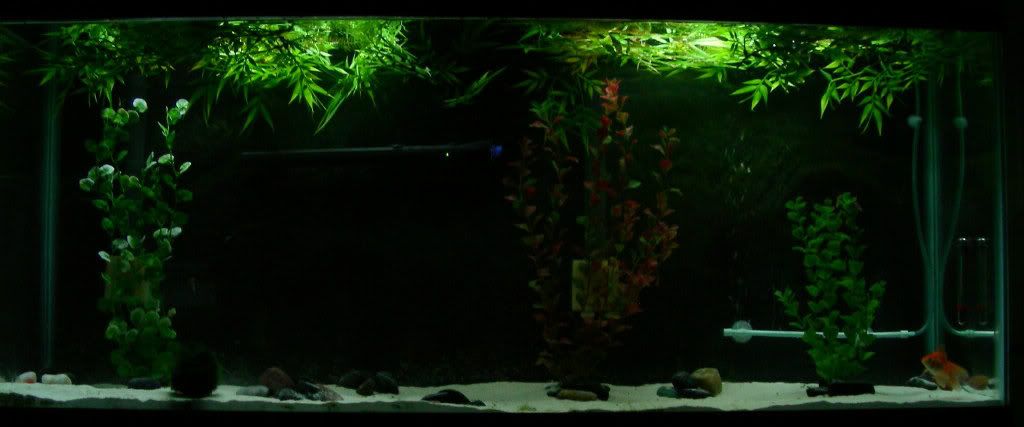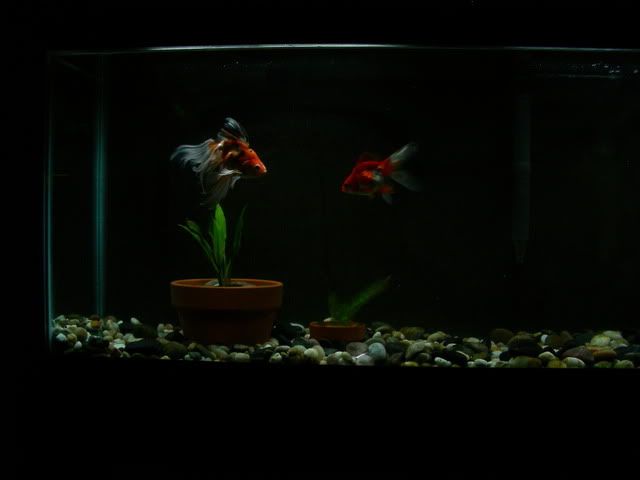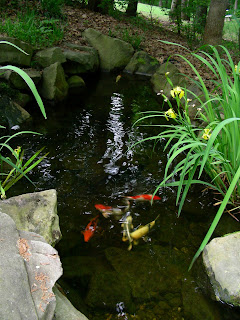As soon as people here I keep aquariums they ask me what my favorite fish are. It's so hard to just pick one, so I've come up with a list of my top ten favorite aquarium fish! Let's count them down!
10. Rummynose Tetra (Hemigrammus bleheri)
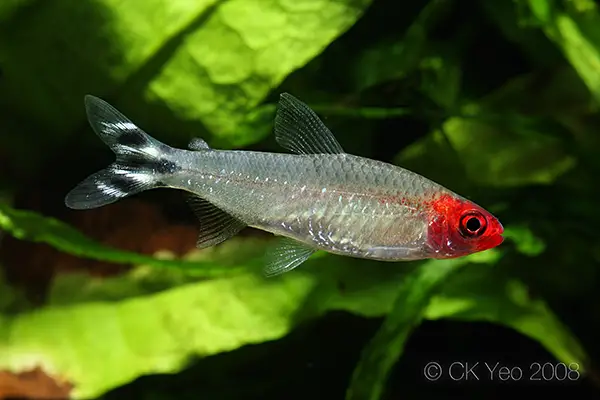 |
| Rummynose tetra individual (SeriouslyFish.com) |
These little beauties are some of the most tightly shoaling tetras in the freshwater world. Sure other tetra will shoal from time to time, but these guys do it almost nonstop. They aren't the most colorful of the tetra, but that lovely red nose sure can shine! Like most of the fish on my list, they are softwater fish. These little beauties can withstand the high temperatures that discus need and are often recommended with them.
9. Twig Catfish (Farlowella spp)
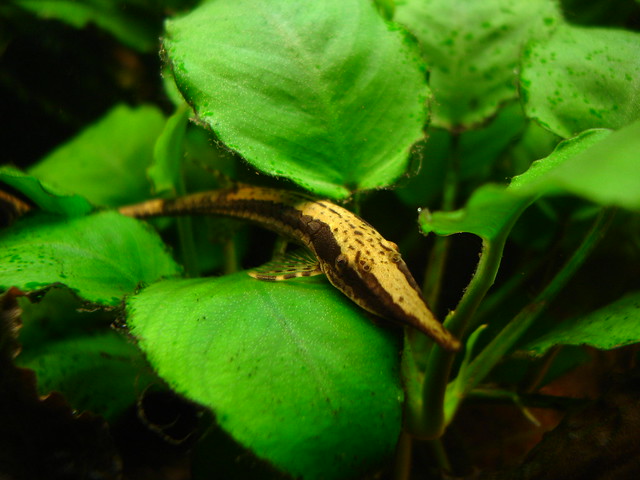 |
| Farlowella spp clinging to Anubias (sampukko @ Flickr) |
This fish lives up to its name. In poorer quality video and pictures it can easily be mistaken for a twig. Its appearance is its camouflage and helps it remain undetected in the wild (and in the aquarium sometimes!). Even though I don't see him every day, I still love my farlowella. They are closely related to plecos but have an almost entirely vegetarian diet. They get quite long (7 inches [17 cm]) but lack the girth to go with it. They get along very well with small fish and shrimps. I've even seen my shrimps climb on him like he was a real twig!
8. Gourami (Trichogaster spp)
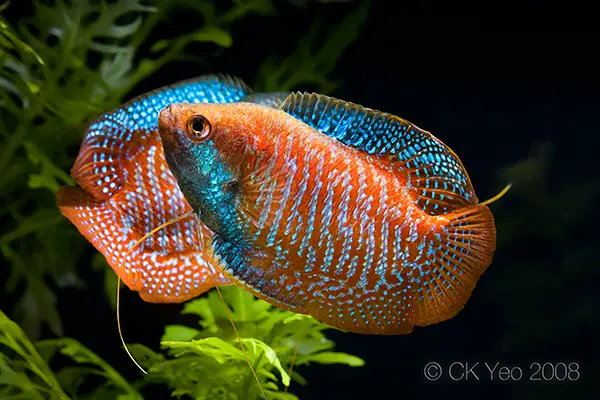 |
| Male dwarf gourami in territorial display (SeriouslyFish.com) |
An air-breather just like bettas, these little fish can make excellent centerpieces for a small tank. They do fine alone or in groups, but it's best to have multiple females per male in a group. They can be a bit territorial towards other gourami and fish that resemble gourami like bettas and cichlids, so if you are keeping multiple gourami in a tank you need to have a lot of hiding spaces for them. Gourami love areas of thick planting as well as floating plants. While I know my male gourami would do fine on his own, I just love watching his colors shine as he displays for his females.
7. Botine loaches (Botia spp)
 |
| Juvenile ladder loaches Botia rostrata playing (Emma Turner @ Loaches Online) |
I fell in love with these guys years ago but have not been able to get them in a tank of mine yet. I saw them playing in a petstore and fell in love. If I were a more capricious person I would have bought them then and there, but I went home and did research. For the most part, the botine loaches need tanks 55 gallons (208 L) or larger. They get larger than you would expect (3+ inches [8 cm] depending on species) and need to be in groups of 6 or more. On top of that, they are very active. But what made me fall in love with these little buggers was the way they interact with each other. They really look like they are playing. They also like to pose in strange positions around the tank which includes laying on their sides or at otherwise odd angles just because they feel like it. For little fishes, they have lots of personality, and I can't wait to get some of these in a tank of mine one day.
6. Discus (Symphysodon spp)
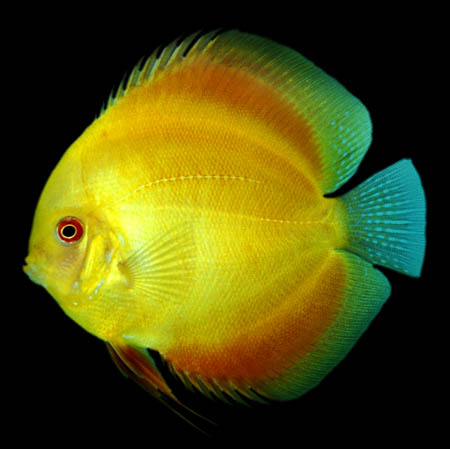 |
| Captive bred discus Symphysodon aequifasciata (SeriouslyFish.com) |
They are called the kings of the aquarium and for good reason. Growing to approximately the size of a CD and coming in rainbow of colors, discus make an impressive sight in an aquarium.Their unusual shape and myriad of colors are what first grabbed my attention, but I was hooked when I saw them swimming in an aquarium. They are so graceful! But with that grace and beauty comes a great amount of care. This coupled with their cost doesn't make them a fish for beginner or even most intermediates. It also makes them difficult to pair with other fish; it's not that they are aggressive, but it's that they need very warm, soft, and acidic water.
5. Cardinal Tetra (Paracheirodon axelrodi)
 |
| Cardinal tetra shoal (Leino88 @ Flickr) |
Another one of the few fish that can withstand the high temperatures discus need, they also rival discus in coloration. Those blue streaks stand out across a room and make them the most beautiful tetra in my opinion. Up close the deep red streak that runs their full body length becomes apparent. Their relaxed and calm nature makes them a great pair with other beautiful fish like gourami and discus. Whether they are in a loosely shoaling group of 12 or in a tight shoal of 50 these tetra stand out in a tank and in my heart. If I could have any tetra in a tank, it would be these guys.
4. Fighting Fish (Betta splendens)
 |
| One of my personal bettas, Lumi the halfmoon plakat |
A lot of people call these little fish with a big attitude, and I'm more than inclined to agree. Every single betta I've owned has been very personable. Those long flowing fins entice many people in, but I am more fond of the rainbow of colors they come in. Another one of my favorite things about bettas is their adaptability to smaller tanks and different water parameters. Bettas were the only fish that I could have in my 5 gal tanks while I was in college. They will also do well in hard or soft water, so you can keep them no matter what your tap water is.
3. Kuhli loaches (Pangio spp)
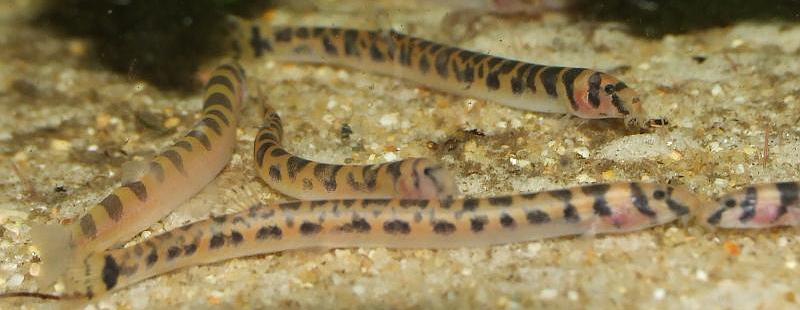 |
| A group of Pangio shelfordii (SeriouslyFish.com) |
Along with the twig catfish, these little guys are some of the strangest looking fish on my list because they don't look like fish! They look like little worms! This is especially true of the brown species. Kuhli loaches have squirmed their way into my heart. Just like the botine loaches they are full of energy and spunk. They like to drape themselves in odd positions around the tank and use those adorable whiskers to sniff out food. They love the company of other loaches and it's not uncommon to see three or four squished together in the same hidey-hole. Many people have trouble with these guy hiding a lot, but I never have. I think it's because I give them enough hiding spaces that they feel comfortable to come out all the time.
2. Goldfish (Carassius auratus auratus)
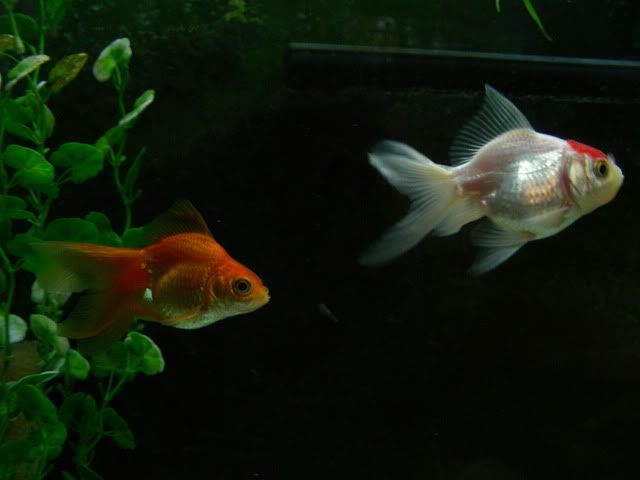 |
| My two current fancy goldfish, Magikarp and Burbbles |
Years ago when I was a young girl, these bubbly little fish stole my heart. My knowledge of their care and love of them have only increased through the years. Yes they need large tanks and lots of water changes, but it's worth it for those wiggly bodies and cute faces. I can't imagine my life without goldfish.
1. Koi (Cyprinus carpio)
 |
| Byakko, my shiro utsuri koi. Taken in 2011. |
While not a true aquarium fish, they are a big part of the hobby and one of my favorite fish. But they didn't start out that way. I never really appreciated them until my little koi that I bought back in 2007 grew into 18 inch (45 cm) beauties. I spend hours in the summer just watching them swim around the pond. In the store, they do just look like large goldfish, but when they are grown there is nothing that rivals their beauty and grace.
I am lucky enough to own a good number of these including goldfish, bettas, koi, kuhli loaches, and twig catfish. One day I will have all of these fish, but some like the botine loaches and discus are potentially a decade away. It's good to have dreams.


























